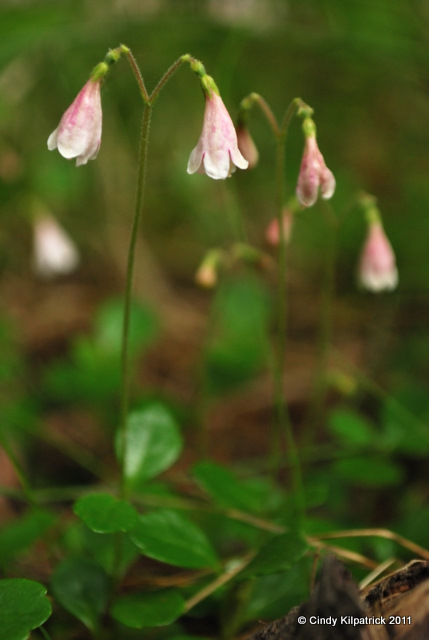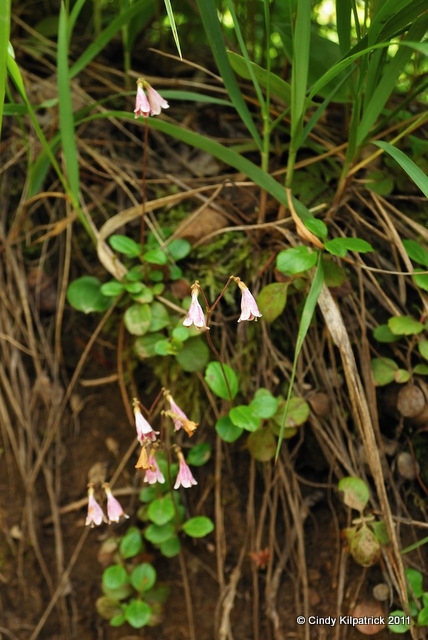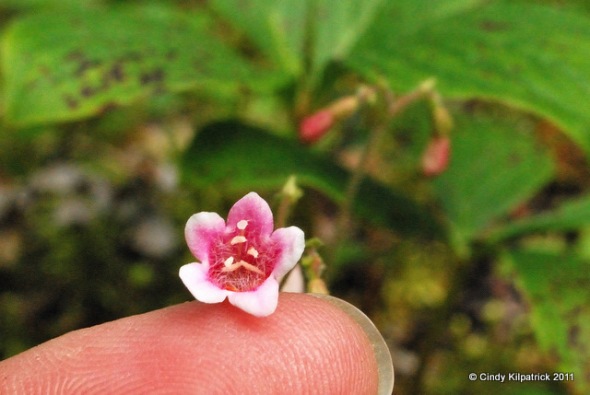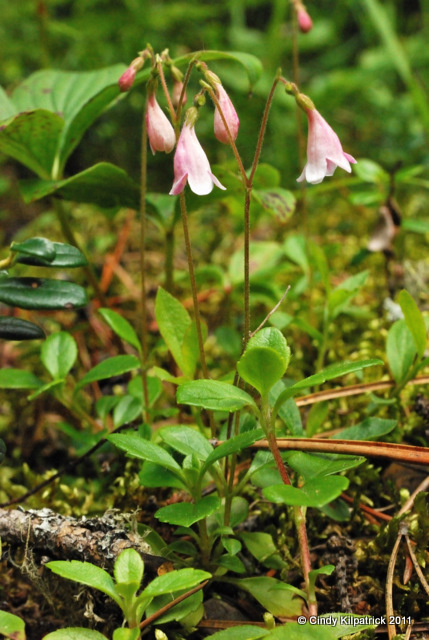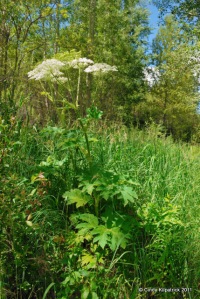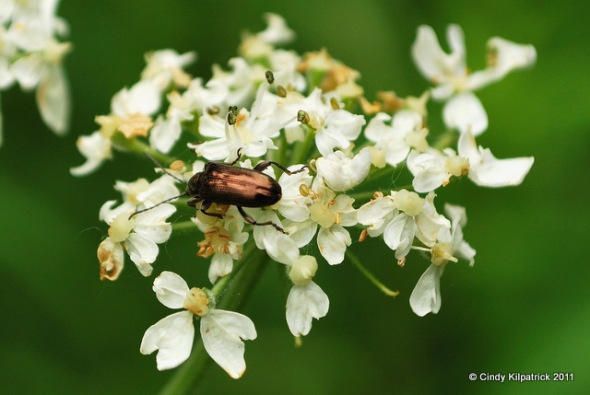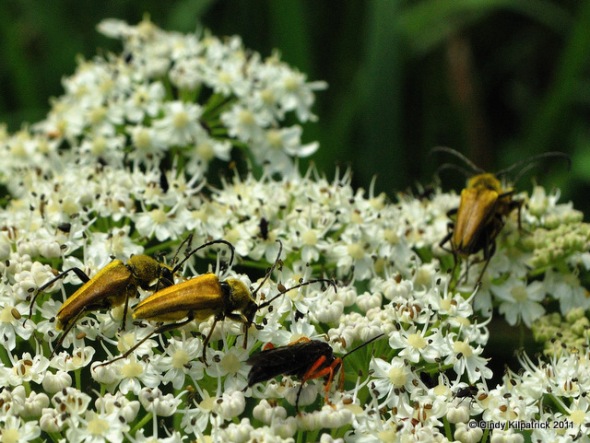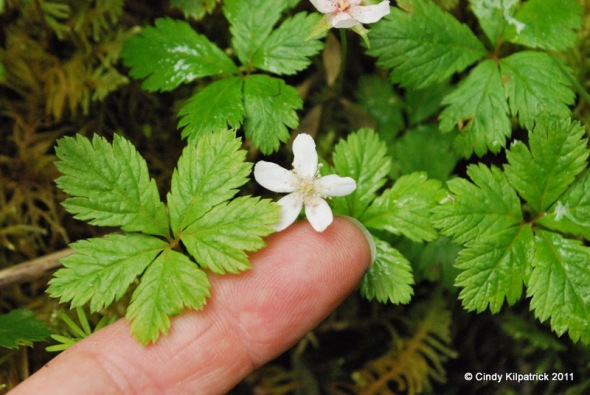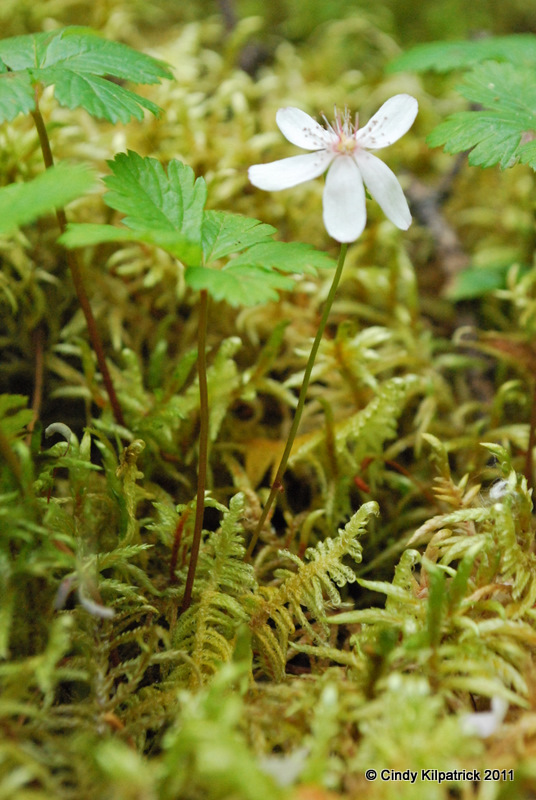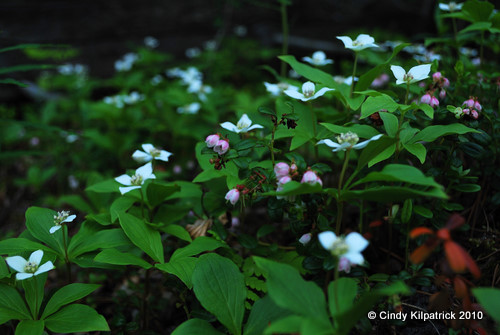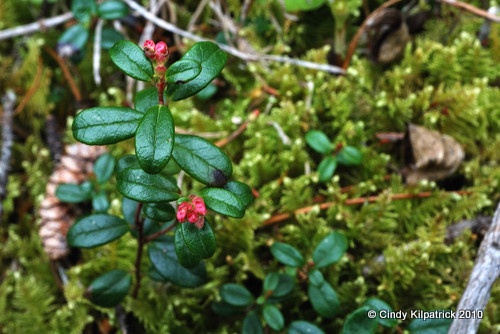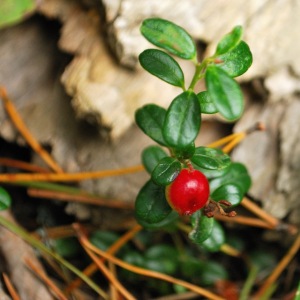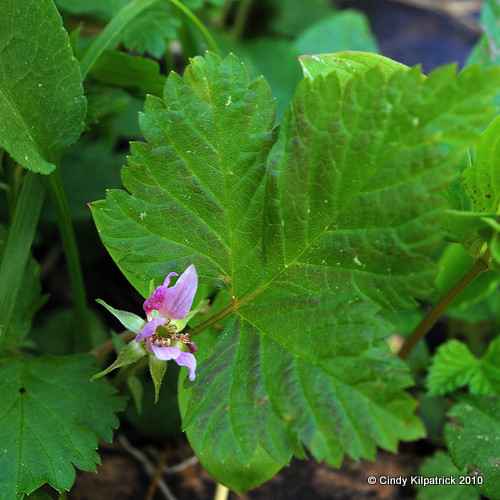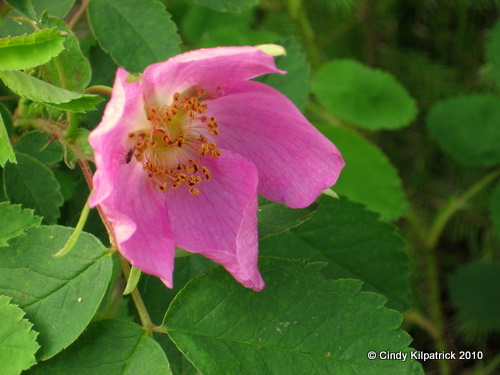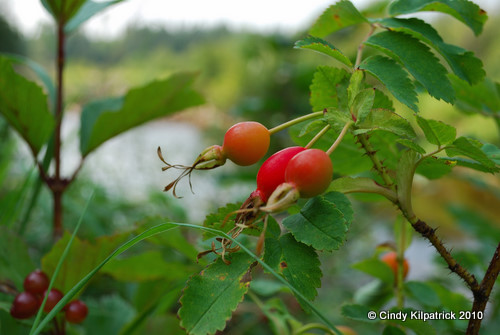Twinflower
or Linnaea, Deer Vine, Ground Vine, Twin Sisters
Linnaea borealis
Delicate and diminutive, this distinctive member of the honeysuckle family grows with the moss among lingonberry and bunchberry. It spreads along the forest floor on lacy vines, sending up clonal shoots at intervals.The Dena’ina name for this sweetly fragrant plant is “k’ela tl’lia” or “mouse’s rope”, a fitting description of the meandering vines depicted well on this page.
This charming plant is circumpolar, but is distinguished by continent. It is interesting and perhaps a warning for other varieties that the subspecies borealis growing in Scotland is threatened by its increasing inability to reproduce due to the fragmentation of its ecosystem. (Read more here.) It is listed as threatened, endangered or extirpated through much of the United States. (link)
Twinflower was the favourite plant of Carlolus Linnaeus, who established the two-name (binomial) system of classification for plants. It was his teacher who officially named the genus, (whose only species member is the twinflower), after Linnaeus and when the latter scientist adopted it as his personal emblem, he said of it, “Linnaea was named by the celebrated Gronovius and is a plant of Lapland, lowly, insignificant, disregarded, flowering but for a brief time—from Linnaeus, who resembles it” (Wikipedia)
Blooming in the early to mid-summer, the elegant twinflower was used by First Nations people for a calming and healing tea. It likes partly shaded areas where the moss is moist and the shed evergreen needles acidify the humus somewhat.
He saw beneath dim aisles, in odorous beds,
The slight Linnaea hang its twin-born heads,
And blessed the monument of the man of flowers,
Which breathes his sweet fame through the northern bowers.
~~~~~~~~~~~~~~~~~~~~~~~~~~~~~~~~~~~~~~~~~~~~~~~~~~~~~~~~~~~~~~~~~~~~~~~~
Other resources:
Plants of the Western Boreal Forest & Aspen Parkland by Derek Johnson et al. Lone Pine, Alberta 1995
Wildflowers of Alberta by R.G.H. Cormack. Hurtig, Alberta 1977
Common Plants of the Western Rangelands: Volume 3 – Forbs by Kathy Tannas. Olds College, Alberta 2004
Wildflowers of the Canadian Rockies by George & Hälle Flygare. Hurtig, Alberta 1986
Yellow Marsh Marigold
or Marsh Marigold, Kingcup
Caltha palustris
While so many of our spring flowers are miniscule, the Marsh Marigold is a delight to discover in an open area by a sluggish stream. The plant itself is brilliant and showy with its large waxy leaves. Many a bowl of reassuring freshness has adorned spring tables through freezing nights and late snows.
It’s so scrumptious looking that you might be tempted to take a bite…but don’t! This entire plant is poisonous. It is toxic to the heart and can cause inflammation of the digestive organs. Handling the leaves can cause the skin to blister. The poison is volatile however and dried or cooked it is rendered harmless.
The spring blossoms of the marsh marigold have long been appreciated for their early colour. Like earthbound sunshine, patches of brilliant yellow set among shining green rise from brown and crumpled grasses in boggy roadside ditches and fens in early to mid June, as if beckoning returning waterfowl to potential, if not ideal nesting sites.
A polymorphic species, it occurs throughout the northern hemisphere in varied forms and goes by many names, most of which celebrate its welcome as a beautiful harbinger of spring. ‘Marigold’, used now over much of the modern english-speaking world, originated with Anglo-saxon celebrants of Easter, who gave the name to honour the Christian St. Mary.
By the end of July the waxy blossoms have done their work and the stellate seed clusters adorn the softened, but still handsome mound of leaves.
Depending on the source, the genus name ‘Caltha’ may refer to the colour or to the cup shape of the opening blossoms. Its species name, ‘palustris’, meaning ‘of the marsh’, clearly describes its habitat.
~~~~~~~~~~~~~~~~~~~~~~~~~~~~~~~~~~~~~~~~~~~~~~~~~~~~~~~~~~~~~~~~~~~~~~~~~~~~~~~
Other Resources:
Plants of the Western Boreal Forest & Aspen Parkland by Derek Johnson et al. Lone Pine, Alberta 1995
Wildflowers of Alberta by R.G.H. Cormack. Hurtig, Alberta 1977
Common Plants of the Western Rangelands: Volume 3 – Forbs by Kathy Tannas. Olds College, Alberta 2004
Caltha palustris on Wikipedia
Flora of the Canadian Arctic Archipelago
Cow Parsnip
or Common Hogweed
Heracleum lanatum (also H. maximum, H. sphondylium)
According to Botanary, this genus of the carrot family was named for Hercules, who was supposed to have used it first for medicine.
This odoriferous species is indeed a plant of muscle: important and commanding as probably the largest perennial in our forest.
It grows in rich moist soil in broad and small forest clearings, rising up to almost two metres by July.
Its huge, 30 cm. compound hairy (lanatus) leaves and equally large flower heads provide landing plantforms and important sustinence for a wide range of insects and birds.
In contradiction to its name and in spite its nutritious foliage, Cow Parsnip is often shunned by cattle and can apparently have a souring effect on their milk when they do eat it. Bears have apparently been known to browse on the flower heads in the spring and in the fall the winged, sunflower-like seeds are popular with birds. After the frost, deer, elk, bears and marmots will eat the stems and leaves.
Roots, young leaf stalks and marrow from the hollow stem were used as food, for rituals, as a yellow dye and medicinally by the North American First Nations and early Europeans although care was taken as sensitive skin can be affected a phototoxin contained in the roots and outer skin.
If you are going to handle Cow Parsnip for any reason it is important that you do not confuse it with other plants of the carrot family that are quite poisonous. Gavan P.L. Watson from Ontario has a good description of the differences here.
~~~~~~~~~~~~~~~~~~~~~~~~~~~~~~~~~~~~~~~~~~~~~~~~~~~~~~~~~~~~~~~~~~~~~~~~~~~~~
Other Resources:
Plants of the Western Boreal Forest & Aspen Parkland by Derek Johnson et al. Lone Pine, Alberta 1995
Wildflowers of Alberta by R.G.H. Cormack. Hurtig, Alberta 1977
Common Plants of the Western Rangelands: Volume 3 – Forbs by Kathy Tannas. Olds College, Alberta 2004
All News in One
Montana Plant Life
Wild Food Girl
Strawberryleaf Raspberry
Rubus pedatus
~ also called Strawberry Bramble, 5-Leaved Bramble and Creeping Raspberry
I’m the kind of person that can have an engaging conversation with you and not be able to tell somebody later what you were wearing, so it was especially exciting for me when I noticed this little plant in a small deep-moss clearing. It’s not so much that I’d never seen it before, it’s that I’d never really seen it!
Perhaps I had never seen it in bloom and may have mistaken its foliage for that of one of its cousins, the Dwarf Raspberry. In bloom I might have assumed that it was another relative, the Wild Strawberry. It’s very tiny.
A closer look reveals that this flower is quite different from a strawberry’s. The petals are more elongated and the centre was different. It had three very distinct superior ovaries with styles that turn pink along with the base of the petals and sepals as the flower matures.
The sepals are drooping at first, as you can see in the top picture and then in more mature blooms raised level below the petals. As the petals fall off it seems they continue to rise to enclose the fruit.
Single leaf and flower stalk emerge separately from the moss, about 5-7 centimetres high.
The leaves were different as well. At first I thought it had five leaflets on its palmately divided leaf, but the side leaflets are just so deeply cleft that there are actually only three.
Apparently the number of ovaries can vary as the fruit can have from 1-6 drupelets.
I had a really hard time identifying this plant. I couldn’t find it in any of my books, or through Internet searching so I posted it to a couple of groups on Flickr that help with this kind of thing. The following day I was very grateful to receive a positive ID from Tiggrx. I later found it in Wildflowers of Alberta by R.G.H. Cormack (Hurtig 1977) as a note within the description for the Dewberry.
There are literally hundreds of plants in the Rubus genus, which it is believed has survived for some 36,000 years and exists on all continents except Antarctica. This little treasure is just another little sibling in the family and I don’t know how long I’ve been rudely ignoring it. It is a beauty. It fully deserves the risk of getting a little damp as you lay down in the soft deep moss to spend some time getting to know it better.
~~~~~~~~~~~~~~~~~~~~~~~~~~~~~~~~~~~~~~~~~~~~~~~~~~~~~~~~~~~~~~~~~~~~~~~~~~~~~~
Resources:
Turner Photographics
E-Flora BC
USDA Plants Database
Many thanks to Tiggrx for identifying this plant for me.
Red & White Baneberry
Actaea rubra
“The generic name Actaea is derived from the Greek aktiai, meaning elder, to which the leaves bear resemblance; rubra alluding to the red berries…” (source)
Most of the sources I’ve found say that the berries can also be white, although Ontario Wildflowers lists the white baneberry as a separate species (A. pachypoda). There are some good photos on that site as well, although their description of the berries of the red baneberry as ‘china white’ is a little confusing.
All parts of this member of the buttercup family are poisonous although several sources claim that native people did use it medicinally. “The name Baneberry refers to the plant’s toxicity, being derived from the Anglo-Saxon word for ‘murderous’ – bana.” (source)
It is apparently quite unpalatable, and there have been no reported deaths from it in North America. The European species has been linked to the deaths of children. (source) Some birds and small animals are able to digest it.
Lingonberry
Vaccinium vitas-idaea also called Bog-Cranberry and Lowbush Cranberry
Lingonberries, especially when not in bloom, can easily be confused with the Common Bearberry (Arctostaphylos uva-ursi), historically known as Kinnikinnik. Around here, the lingonberries are a denser plant, while the bearberry seems to grow more openly, but I am never sure of my identification until the flowers bloom. A magnifying glass helps, as the lingonberry has bristle-like glands on the lower side of the leaf.
Once in bloom, the flowers are, although similar, are distinguishable on close inspection. The bell of the bearberry’s flowers is ‘tucked-in’ or more urn-shaped.
Vaccinium have been used traditionally in North America for the cranberry sauces commonly served with turkey dinners at Christmas and Thanksgiving, although this northern species is only lately being tried as a commercial plant.
Northern native people, however, have always known of and used lingonberries as food. In fact it was one of the most important berries for them and used almost exclusively in pemmican. The plant was also used medicinally, for jewelry, as a dye for porcupine quills and a tobacco-stretcher. (Source)
In this Mi’kmaw legend, the cranberry (presumably lingonberry or a close relative) warded off bad magic. And who knows what cranberry sauce had to do with strawberries.
Low Bush-Cranberry
Also called Squashberry & Mooseberry (Viburnum edule). Confusingly they are also referred to in some parts as High Bush-Cranberry, which in my area is the common name for Viburnum Opulus
How about some more confusion: is this the Christmas fruit? No. Bush-Cranberries are not related to the cranberries associated with turkey dinners. Viburnum is a member of the Honeysuckle family while the berries grown for cranberry sauce (Vaccinium) are much more low-growing and have leathery leaves as do most plants in the Heath family.
However, bush-cranberries are edible although a little tart when fresh for most palates. They do make excellent jams and jellies though and are very healthy, being very high in Vitamin C. All parts of the plant have been used historically by the native people in North America for centuries for not only food, but medicinally. (Source)
They were so prolific here on the Freeman River – mid August – I’ll have to go back next spring and take some pictures of the little white flower bunches that turn into these rich, juicy berries. I was surprised that they did not seem to have yet been significantly browsed by the forest critters.
Dwarf Raspberry
Dwarf or Stemless Raspberry / Dwarf Nagoonberry ( Rubus acaulis)
Though small, you’re not likely to miss this little treasure in the woods. The flower is brilliant pink and stands proudly above the shiny, textured leaves.
The delicious berries, however are a little more difficult to find, possibly because critters found them before you but also because they’re quite tiny – about 1cm. Indeed, they’re so good that I usually forget to take a picture before I eat them. 🙂
Prickly Rose
Prickly rose, Rosa acicularis is the provincial flower of Alberta. Confusingly, it is often confused with the more or less abundant (depending on the source) common wild or wood rose (R. woodsii), which has fewer thorns.
Most of the plant is edible and the hips are extremely high in Vitamin C as well as several other vitamins, however moderation is advised as over indulgance can cause diarrhea. The hairy seeds within the hip can irritate the digestive track and cause discomfort on elimination.
Various parts of this beautiful, and beautifully scented shrub was used by native people for food, drinks, medicines, jewelry, toys, and to smoke.
The popular rose scent is expensive for a reason: according to my favourite plant resource, sited here, “It takes 60,000 roses to produce 28 ml of pure essential oil”. That’s a lot of flowers!
This species is nearly circumpolar. According to Monstropedia a dead person could be prevented from turning into a vampire by “placing a thorny branch of wild rose in the grave”.

